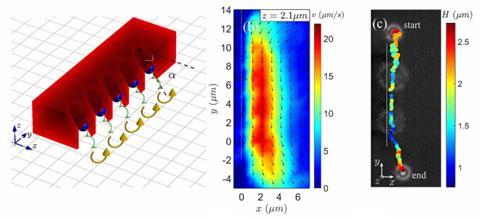Researchers propose a new way to transport materials through tiny devices
Scientists in China have trapped bacteria in 3D-printed structures and used them to pump materials along customised paths.
Transporting materials in the microscopic world is complex. Conventionally, macroscopic pumps drive motion, but pumps are bulky and not ideal for miniaturisation. Now, Hepeng Zhang and colleagues at Shanghai Jiao Tong University have tackled this problem using native inhabitants of the microscopic world – motile bacteria. Not only are they already present in the media, but their energy conversion efficiency is estimated to be greater than existing man-made micro-motors.
Flagella are the whip-like structures that propel some bacteria forward. When a bacterium moves in a fluid, its flagella create a flow in the same way we do when swimming in a pool. So imagine numerous bacteria or swimmers aligned in proximity: the flow is strong enough to transport materials.
‘We noticed some bacteria stuck on a glass coverslip could generate flow; this led us to the idea of using immobile bacteria as pumps,’ explains Zhang. If a single confined bacterium generates transporting flow, they reasoned that confined bacteria could act as basic building blocks to design flow patterns. ‘We tried different ways to organise bacteria and found that microstructures are particularly suitable,’ he adds.
Designing these microstructures was challenging. A 3D printer focuses light into a liquid resin, which is harmless to bacteria, and transforms the liquid around the focal point into a microscopic solid brick. By scanning the focal point along a predefined trajectory, the printer builds the desired structure, brick by brick.

Each structure has many micro-sized cavities. When a bacterium swims into a cavity, its inability to swim backwards leaves it trapped. Microorganism locomotion expert Saverio Spagnolie from the University of Wisconsin in the US describes these cavities as ‘tiny covered garages.’ Scientists have investigated monolayers of beating flagella before, he says, but this new work ‘achieved much greater control of the flow field. An important inverse problem is then: given a desired flow field, how should you design the microbial parking lot?’
Zhang anticipates that microorganisms with higher swimming speeds will allow them to ‘make the generated flow faster and cover a larger area’.
References
This article is free to access until 10 December 2015
Z Gao et al, Lab Chip, 2015, DOI: 10.1039/c5lc01093d












No comments yet